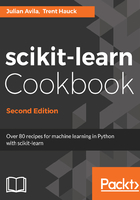
How it works...
In machine learning, we often deal with data tables and two-dimensional arrays corresponding to examples. In the iris set, we have 150 observations of flowers of three types. With new observations, we would like to predict which type of flower those observations correspond to. The observations in this case are measurements in centimeters. It is important to look at the data pertaining to real objects. Quoting my high school physics teacher, "Do not forget the units!"
The iris dataset is intended to be for a supervised machine learning task because it has a target array, which is the variable we desire to predict from the observation variables. Additionally, it is a classification problem, as there are three numbers we can predict from the observations, one for each type of flower. In a classification problem, we are trying to distinguish between categories. The simplest case is binary classification. The iris dataset, with three flower categories, is a multi-class classification problem.